Wagon-House Cliff
We had three days and three nights to meet a friend, do a photo workshop and kickstart our year end (2014) vacation in South Africa (where else?!?). We have done numerous wildlife workshops with David Rogers, our friend and mentor. This time we wanted to try something different. I remembered a picture of his which had haunted me for many weeks and months. It was of a ship wreck near Cape Agulhas. And so was born the idea of seascapes … David suggested staying at Arniston. He tantalised us with descriptions of a quaint fishing village. He wrote to us of pristine beaches and magical caves. He spoke of sunrises and sunsets to rival any place on earth. It sounded perfect.
It was perfect.
The Cape South region is a place of unbridled natural beauty. Where the seas go from a stunning emerald green to an incredible cerulean blue. Where the gentle breeze can turn into a raging storm.
Arniston / Waenhuiskrans – the double name is a bit of a mouthful for a tiny town. Yet its a place that is more than capable of bearing this weight with pride and dignity. A place where history is soaked into every grain of sand and every craggy cliff. Where scores of ships crashed and explorers and pioneer families died. Indeed, the first part of the town’s name came from the the tragic wrecking of the HMS Arniston in 1815. The ill fated vessel had 378 people on board. 6 survived to tell the horrific tale.
But this is just relatively recent history. Remains of impements, bones of fish and mammals and other evidence clearly show that the land was occupied by hunter gatherers nearly 2000 years ago. More recent evidence from around the 16th century suggests that ethnic tribes had contact with survivors from ship wrecks – explorers from various parts of Europe.
We had booked into a self-catering cottage nestled in the back streets, simply furnished with the sea as its decor theme in every room.
Glass lamps filled with sand, shells for bowls.
And a Christmas Tree made of driftwood. Mc Gregor House was perfect too!
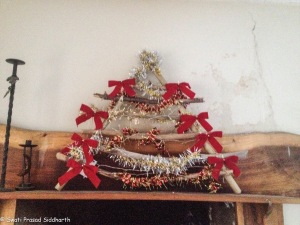 Walking down towards the main beach in town, we rounded a corner and spread before us, suddenly, was this unbelievably blue ocean edged with glittering white sand … cottages dotted in the distance, a scene ready for a painting.
Walking down towards the main beach in town, we rounded a corner and spread before us, suddenly, was this unbelievably blue ocean edged with glittering white sand … cottages dotted in the distance, a scene ready for a painting.
Pulled up on the slipway cum harbour were numerous colourful fishing boats. They spoke silently of adventure and colour, fear and victory. They spoke of hard times and happy times. Of man’s fight for survival against all odds. They spoke of daily life of the residents of Kassiesbaai.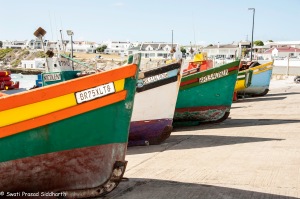
Nestled between sand dunes and ocean, Kassiesbaai is the little fishing hamlet on the outskirts of Arniston. It was built about two centuries ago. The name derives from “Kassies” (Afrikaans for paraffin cases) – the houses were built of these cases washed up from shipwrecks – and limestone and thatch from the surrounding land.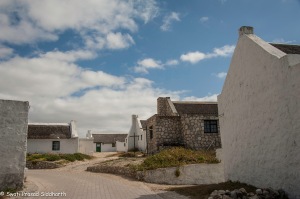
This is a community of generations of fishermen who have fought for and survived incredible odds. They have held onto their land, their occupation and their traditions in spite of regular socio-political upheavals over the centuries. This, apart from all that nature throws their way – the simplest challenges being natural decay over time. Since 1986 Kassiesbaai is a National Heritage Site. Unchanged over time, besides the rustic charm of the village, are the residents who continue to be cheerful, friendly, welcoming and warmhearted.
We walked the trails along the beach, up and down gold-white sand dunes. We walked up the cliffs at dawn when the very rocks seem to take on the shimmering hues of the sun.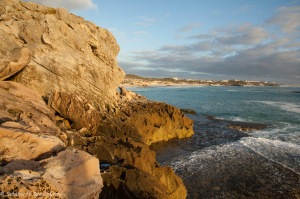
We climbed sand dunes to watch the sun set.
A morning drive into the Malagas region took us to the small and exclusive vineyard, Sijnn Wines, overlooking the meandering Breede River.
While we did not meet the owner, David Trafford, we were hosted by the charming and enthusiastic Charla Haasbroedk, Assistant Winemaker. We walked around the grapevines as she told us about her home. The creating (“making” sounds tame!) of the perfect wine from the selection of the location to grow the grape to the final bottling is a long and unpredictable journey. Perfect wines are never assured. But when this science and art attain exquisite balance, the vintner has achieved his miracle …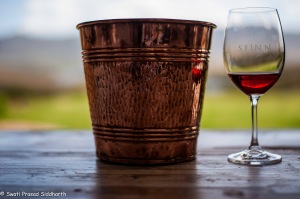
While we were reluctant to leave this idyllic location, we knew we had to. We had a very special place to visit that afternoon, at a very specific time.
The second part of the name for the town, Waenhuiskrans, meaning wagon-house cliff, comes from an enormous limestone cave (originally called Holkrantz) on one of the beaches. The cave itself got its name from being large enough to turn a wagon with its full span of of oxen hitched!
We climbed down a cliff and waded through shallow water to enter the cave from its rear. Indeed, this is the only access to the cave from land and that only at low tide.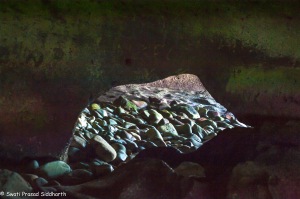
Bending down double and almost crawling on rocks encrusted with molluscs and sharp as nails, we stepped into the cavern and simply lost our breath.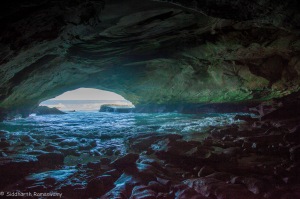
The immensity of the cave is overshadowed only by the stunning view of the open ocean at the mouth of the cave. As our eyes adjusted to the darker interior, the colours on the walls and roof of the cave held us spell bound. The tide was rising and rising fast. We had but a few minutes to breathe in the magic and promise ourselves a return visit.
An hour’s drive from Arniston brought us to Cape Agulhas, the geographic southern tip of the African Continent. This is where the Indian Ocean “officially” meets the Atlantic Ocean. The place was named by Portuguese sailors “Cabos das Agulhas” or “Port of Needles” – after they found that the compass needle (the direction of the magnetic north) coincided with the true north.
The storms, conflicting water currents and the shallow continental shelf off this coast have made this cape notorious for centuries among sailors. The entire region is littered with wrecks (The HMS Arniston being one of the most infamous). A lighthouse was built here in 1848 to aid navigation. It is now a small museum with a little restaurant attached.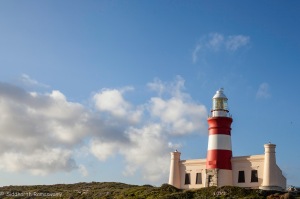
Inspite of being a nautical nightmare, Cape Agulhas region is a place of beauty. Rugged rocks crop out of the oceans. Beaches are pristine. And tourists are fewer than expected. As we walked along the beaches and shallow pools, the present faded away and left us with a feeling of being in the distant past. Where pioneering ships sailed by – or wrecked themselves – and sailors and survivors had to learn to live with the land and the sea and build a happy life for themselves out of loss and hardship. Their ingenuity and resourcefulness was what would keep them alive. Their stubbornness to be happy would ensure that they never surrendered to their trials …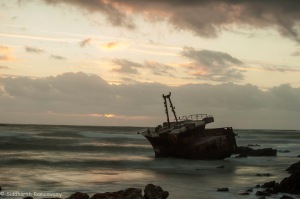

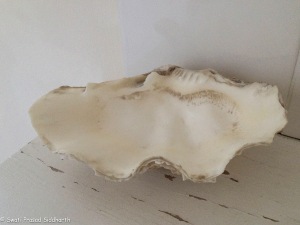

sounds like you’ve been having a great time!
LikeLiked by 1 person
As I said on FB, the pictures combined with the narrative really made the story come alive. You should write about all your trips 🙂
LikeLike
Thank you! And we have written bout most of our trips in the last two years …
LikeLike
Hi honey,Everyone one has already expressed everything I wanted to say.well,Ican only say that the pictures and the very vivid write up make you feel as if one is very much there seeing and feeling the magical moments. Manjula aunty
LikeLike
Thank you Aunty. Irrespective, this critique do yours is very special since it’s the first one for our blog. And we hope to be sharing at least some of these magical moments with you.
LikeLike
Incredible and awesome pictures with a beautiful write up that takes us to those adorable places. We feel we are there to see each and every thing that has been magnificently described. Honey dear, your description is simply Superb. Keep on going to such places and wring about them. May God Bless you.
LikeLike
Thank-you, Amma.
LikeLike
Looks a MUST make visit trail, made more so by your fabulous description and photohraphs of the place. The last pic ends the write up suddenly, though one searches for more.
Keep up the good work on the thrilling places you have visited. Look forward to them soon.
LikeLike
Thank you Appa. Yes, hopefully the last pictures does leave you wanting more … We certainly want more …
LikeLike
Just reflecting about your writings. Most of us would have just enjoyed such a trip, savoured the moment and would have forgotten when we left ghe place(s). I am happy that you have not only not forgotten, but have succeeded in etching the beauty of the nature’s exotic creations.
LikeLike
Thank you again!
LikeLike
Great words and photos, Swati … even the Gods would envy you.
LikeLike
Thank you, Srini!
LikeLike
Beautiful words and photographs – you are a gift Swati, even the Gods would envy you.
LikeLike
As always, you have a gift of stringing together apt words to re-capture your amazing experiences. And while at that, your reader too is drawn into that unique
world you create. Thank you. Glad you had a fantastic holiday…
LikeLike
Thank you Savitha. Coming from you, I particularly treasure those words. Hopefully we can do this again, soon, with you. You will surely fall in love with this place.
LikeLike
wonderful writing Swati
LikeLike
It was a wonderful holiday. Happy memories and a land the kind you only dream of … Thank you for introducing us to the place and for making it all happen. 😄
LikeLike
Your writing is excellent Swati — clear and so
LikeLike
Beautifully written :_
LikeLike
Thank you Preeti. We had a beautiful holiday with you. Such good memories.
LikeLike
Beautifully written Swathi. Fantastic description and photos! Keep writing!
LikeLike
Thank you, Aunty.
LikeLike